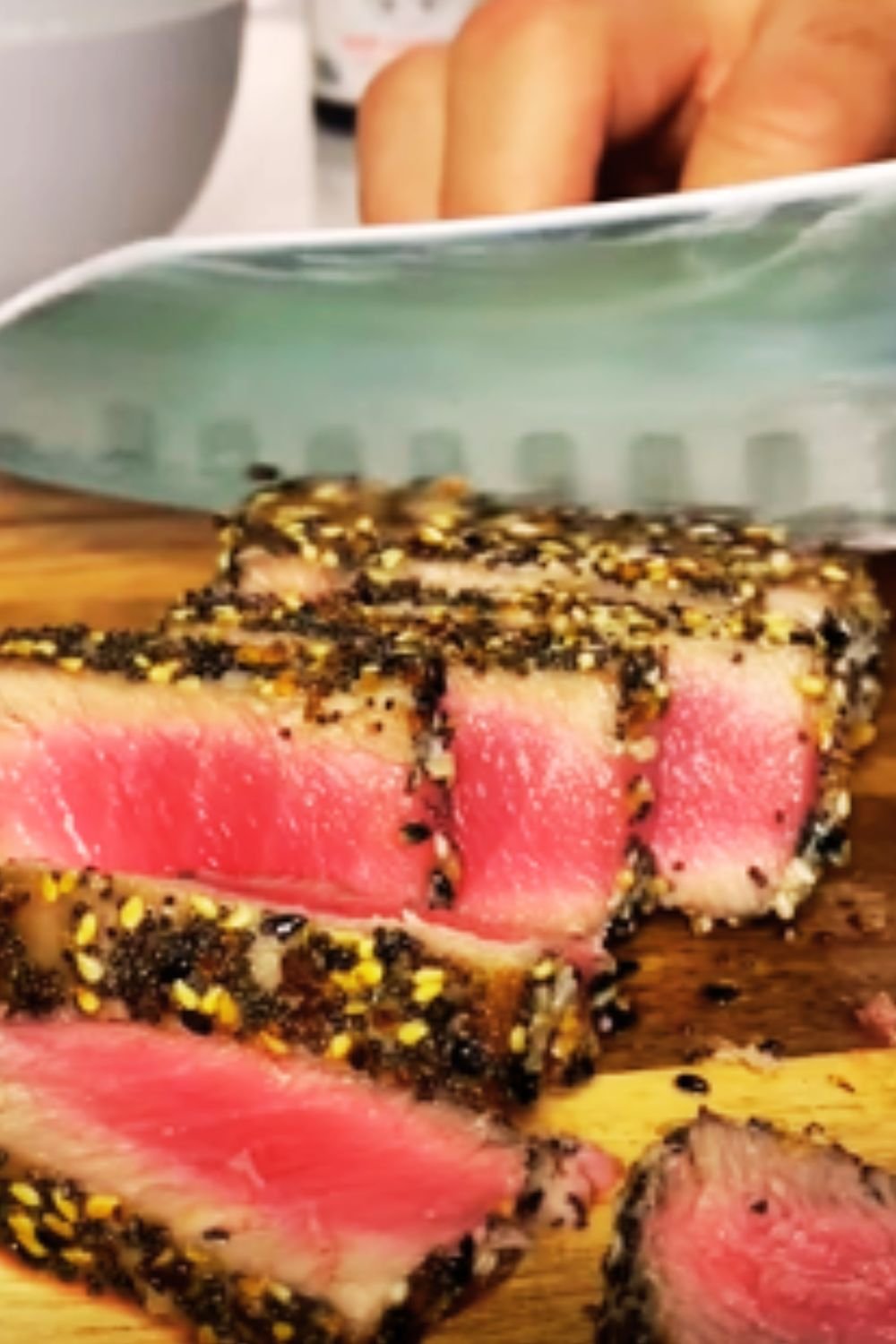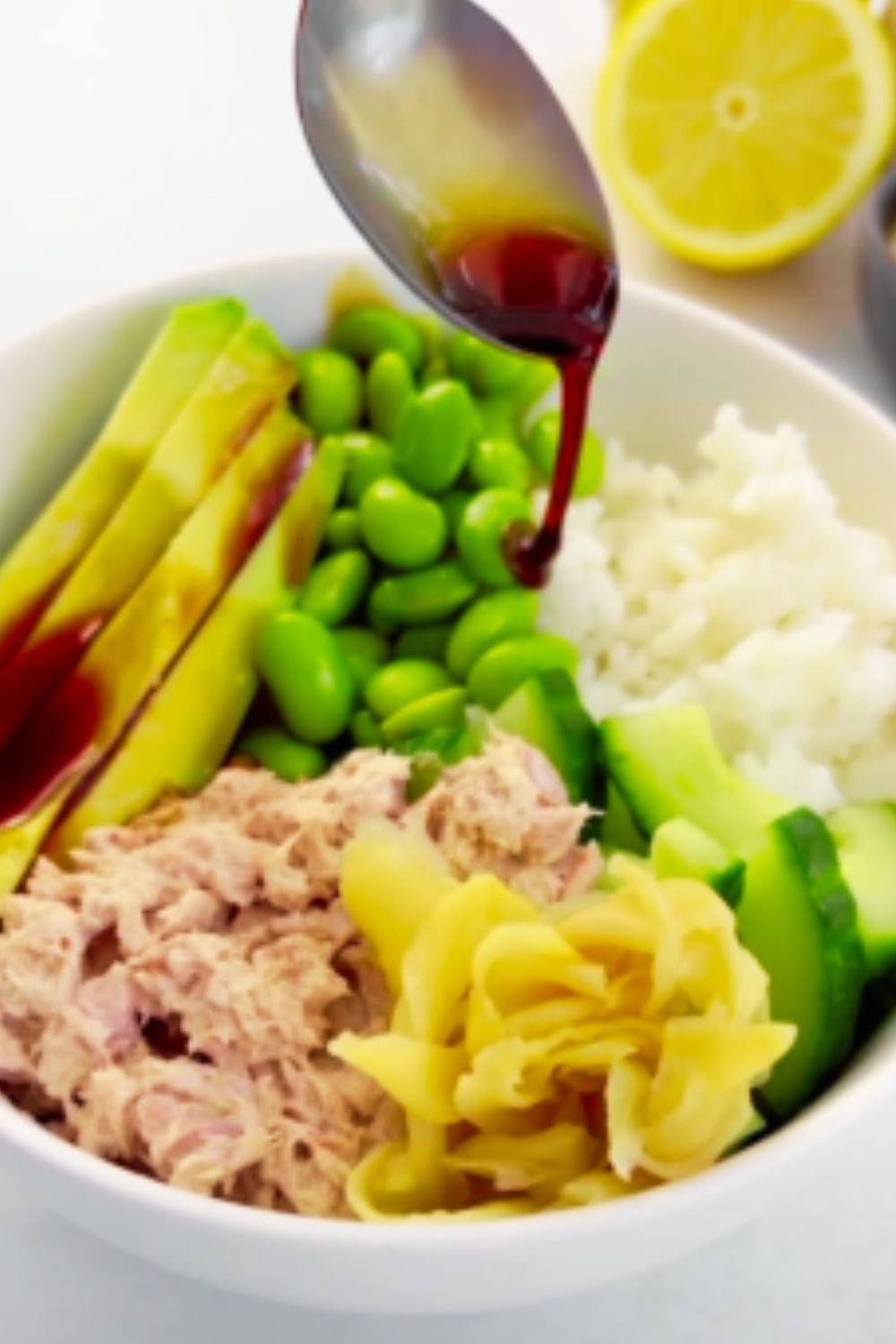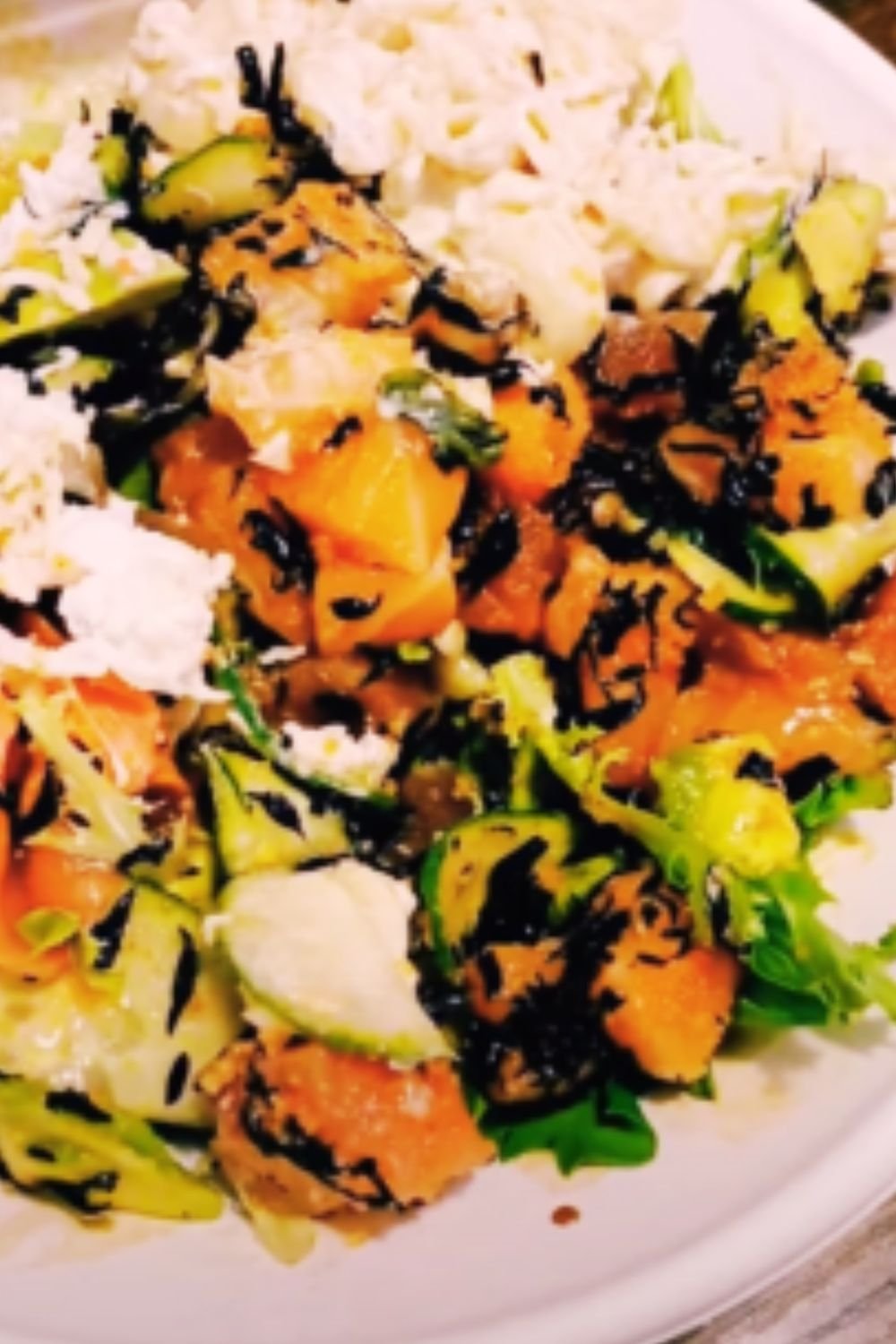Have you ever ordered seared ahi tuna at a restaurant and wondered if you could recreate that same melt-in-your-mouth experience at home? I certainly did, and after years of experimenting with different techniques, I’m thrilled to share my foolproof method for making restaurant-quality ahi tuna steaks in your own kitchen.
Ahi tuna (also known as yellowfin tuna) is prized for its firm texture and rich, buttery flavor. When properly prepared, it should have a beautifully seared exterior while remaining rare to medium-rare in the center. The best part? It takes just minutes to cook, making it perfect for both weeknight dinners and impressive entertaining.
What Makes Ahi Tuna Special?
Ahi tuna isn’t just any fish—it’s a culinary superstar that deserves special treatment. Before we dive into the cooking process, let’s understand what makes this particular fish so exceptional:
- Flavor Profile: Unlike other fish varieties that can be mild or even bland, ahi tuna has a distinctive rich, meaty flavor that’s often compared to high-quality beef steak.
- Texture: The firm, dense texture stands up to various cooking methods and holds together beautifully when sliced.
- Versatility: While searing is the most popular preparation method, ahi tuna can also be served raw as sashimi, lightly marinated as poke, or even grilled.
- Nutritional Powerhouse: Packed with high-quality protein, omega-3 fatty acids, selenium, and vitamin B12, ahi tuna is as nutritious as it is delicious.
Selecting the Perfect Ahi Tuna
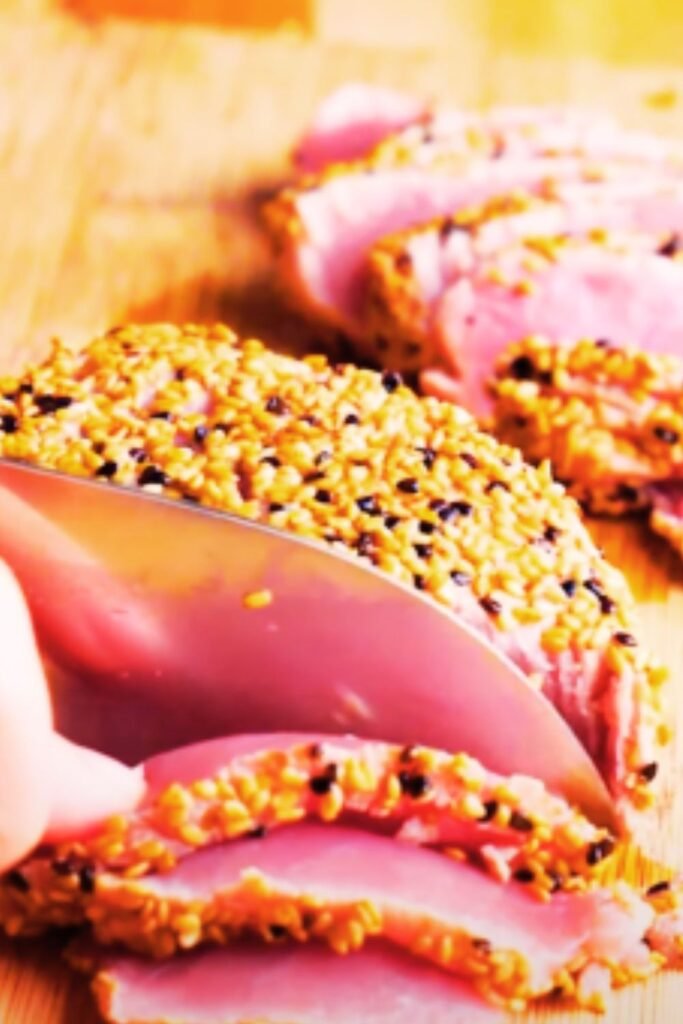
The secret to an outstanding ahi tuna dish starts at the market. Here’s what I look for when selecting tuna steaks:
Sushi-Grade or Sashimi-Grade: Since we’ll be serving the tuna rare in the center, it’s crucial to purchase the highest quality fish possible. Look specifically for labels indicating “sushi-grade” or “sashimi-grade,” which signifies that the fish has been frozen according to FDA guidelines to kill potential parasites.
Color: Fresh ahi tuna should have a vibrant, deep red or pink color—never brown or dull. The flesh should be translucent and glistening.
Smell: Fresh tuna should have virtually no fishy odor. If it smells strongly of fish, it’s not fresh enough for serving rare.
Texture: The flesh should be firm to the touch and spring back when pressed lightly. Avoid any fish that feels mushy or leaves an indentation when pressed.
Sustainability Considerations
When purchasing ahi tuna, I always try to make environmentally responsible choices:
- Look for tuna that’s been pole-caught or troll-caught, which has less bycatch than other fishing methods
- Check for Marine Stewardship Council (MSC) certification
- Ask your fishmonger about the source of their tuna and opt for locally caught when possible
- Consider using the Seafood Watch app to check current sustainability recommendations for yellowfin tuna in your region
Essential Ingredients for Perfect Ahi Tuna Steaks
For the most flavorful result, here’s what you’ll need:
| Ingredient | Amount | Notes |
|---|---|---|
| Ahi tuna steaks | 2 (6-8 oz each) | Sushi-grade, 1-1.5 inches thick |
| Sesame oil | 1 tablespoon | Toasted variety for deeper flavor |
| Soy sauce | 2 tablespoons | Low-sodium preferred |
| Fresh ginger | 1 tablespoon | Finely grated |
| Garlic | 2 cloves | Minced |
| Lime | 1 | For juice and zest |
| Sesame seeds | 1/4 cup | Mix of black and white for visual appeal |
| Kosher salt | 1 teaspoon | |
| Freshly ground black pepper | 1/2 teaspoon | |
| High-heat oil | 2 tablespoons | Avocado, grapeseed, or peanut oil |
For the Optional Dipping Sauce:
| Ingredient | Amount | Notes |
|---|---|---|
| Soy sauce | 3 tablespoons | Low-sodium preferred |
| Rice vinegar | 1 tablespoon | Unseasoned |
| Wasabi paste | 1 teaspoon | Adjust to taste |
| Scallions | 2 | Thinly sliced |
| Sesame oil | 1/2 teaspoon | |
| Honey | 1 teaspoon | For balance |
Essential Equipment
Having the right tools makes all the difference when preparing ahi tuna:
- Heavy-bottomed skillet: Preferably cast iron for superior heat retention and distribution
- Instant-read thermometer: To ensure perfect doneness
- Sharp knife: For clean slicing of the cooked tuna
- Timer: Precise timing is crucial for perfect doneness
Step-by-Step Preparation Method
Step 1: Marinate the Tuna (Optional but Recommended)
While you can simply season the tuna with salt and pepper before searing, I find that a brief marinade adds wonderful depth of flavor. Here’s my go-to method:
- In a shallow dish, combine the sesame oil, soy sauce, grated ginger, minced garlic, and lime zest.
- Place the tuna steaks in the marinade, turning to coat both sides.
- Marinate for 15-30 minutes at room temperature. Don’t exceed 30 minutes, as the acids in the marinade will begin to “cook” the fish.
Step 2: Prepare the Sesame Crust
- On a plate, mix the black and white sesame seeds with a pinch of salt and pepper.
- Remove the tuna from the marinade and pat dry with paper towels. Drying the surface is crucial for achieving a good sear.
- Press each tuna steak into the sesame seed mixture, coating all sides evenly.
Step 3: Heat the Pan
Getting your pan to the perfect temperature is critical for searing tuna:
- Place a heavy-bottomed skillet (preferably cast iron) over high heat.
- Add the high-heat oil and heat until it’s just beginning to smoke. A properly heated pan is non-negotiable for achieving that perfect sear without overcooking the center.
Step 4: Sear to Perfection
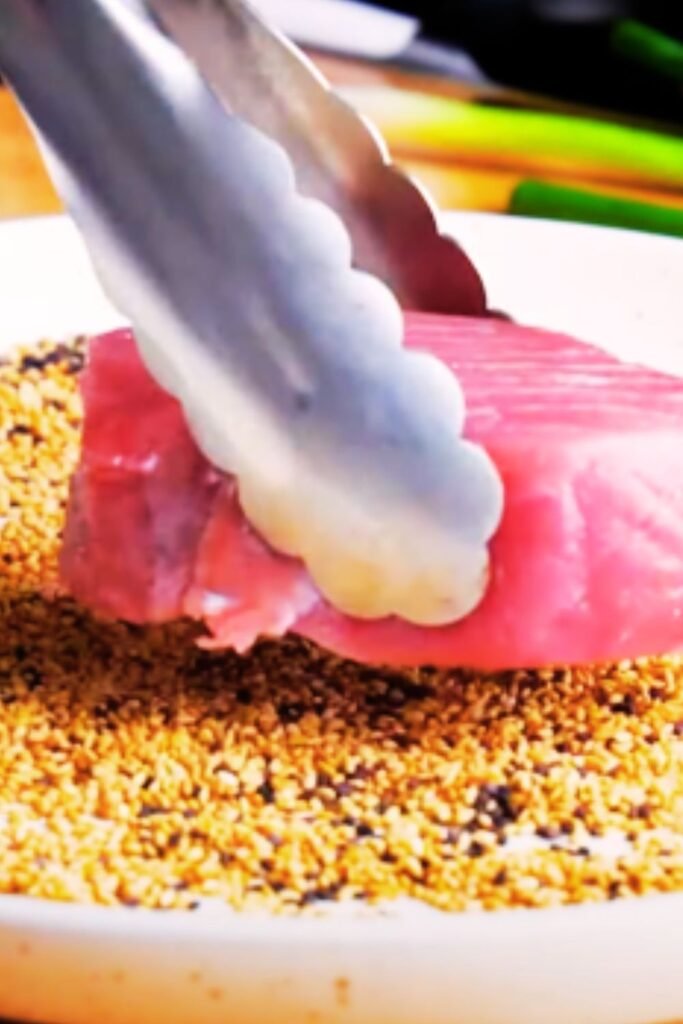
Here comes the exciting part—the actual cooking, which happens very quickly:
- Carefully place the sesame-crusted tuna steaks in the hot pan. They should sizzle immediately upon contact.
- Sear for exactly 45 seconds to 1 minute per side for rare (recommended), or up to 2 minutes per side for medium-rare.
- Using tongs, briefly sear the edges of the steak, about 15 seconds per edge.
- The ideal internal temperature is 115°F (46°C) for rare or 125°F (52°C) for medium-rare. Use an instant-read thermometer inserted into the thickest part to check.
Step 5: Rest Before Slicing
This step is often overlooked but is crucial for the best texture:
- Transfer the seared tuna to a cutting board and let rest for 5 minutes. This allows the juices to redistribute throughout the fish.
- Using a very sharp knife, slice the tuna against the grain into 1/4 to 1/2-inch thick slices.
Temperature Guide for Perfect Doneness
For those who prefer precise control, here’s my temperature guide for ahi tuna:
| Doneness | Internal Temperature | Appearance | Texture |
|---|---|---|---|
| Rare (Recommended) | 110-115°F (43-46°C) | Deep red center | Soft, tender, buttery |
| Medium-Rare | 120-125°F (49-52°C) | Pink center with light brown edges | Firmer but still tender |
| Medium | 130-135°F (54-57°C) | Light pink center with gray-brown edges | Firm, less juicy |
| Well-Done | 140°F+ (60°C+) | Gray-brown throughout | Dry, tough (not recommended) |
Note: For food safety when serving tuna rare, always use sushi-grade fish that has been properly handled and stored.
Serving Suggestions
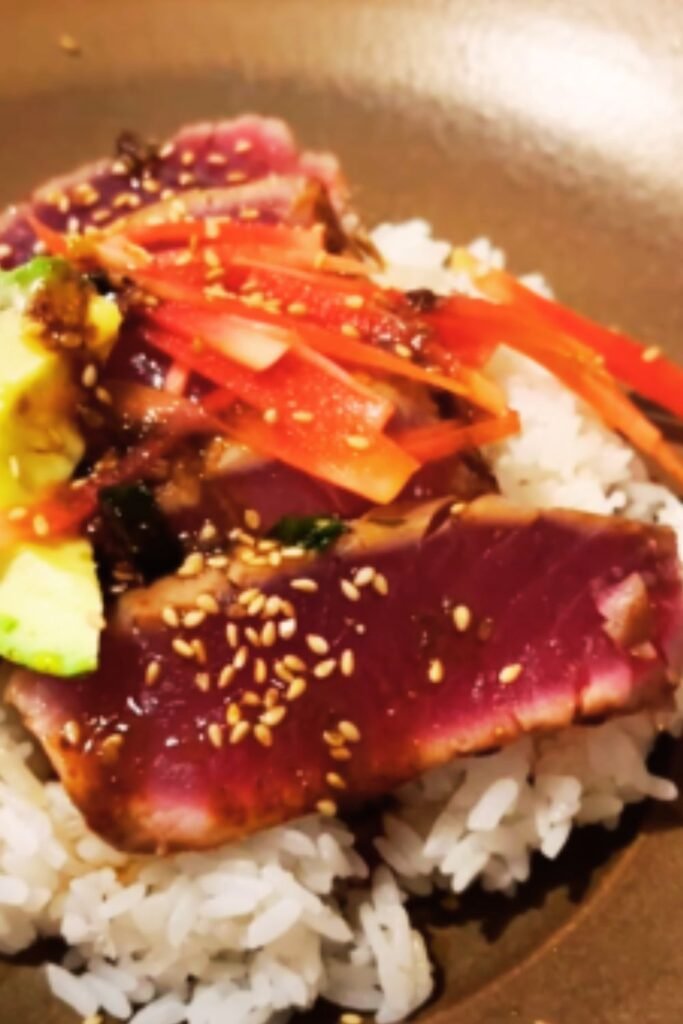
The beauty of seared ahi tuna is its versatility. Here are some of my favorite ways to serve it:
As a Main Course
- With wasabi mashed potatoes and steamed bok choy
- Over soba noodles with a ginger-scallion sauce
- Alongside coconut rice and a fresh mango salsa
- With roasted sweet potatoes and a sesame-ginger vegetable stir-fry
As an Appetizer
- On cucumber rounds with a dot of wasabi and micro greens
- In lettuce cups with avocado and a soy-lime dressing
- With wonton crisps and a spicy aioli
- As part of a seafood platter with pickled ginger and wasabi
In Salads and Bowls
- Sliced over mixed greens with a sesame-ginger dressing
- In a poke bowl with rice, avocado, edamame, and seaweed salad
- With quinoa, roasted vegetables, and a miso dressing
- In a composed Niçoise-style salad with green beans, potatoes, and olives
Recipe Variations to Try
Once you’ve mastered the basic seared ahi tuna, try these delicious variations:
Spicy Crusted Version
Create a spicy coating by mixing 1 tablespoon of togarashi (Japanese seven-spice powder) with your sesame seeds before crusting the tuna.
Herb-Infused Approach
Add 1 tablespoon each of finely chopped fresh cilantro and mint to your marinade for a bright, herbaceous flavor profile.
Asian-Fusion Style
Brush the tuna with Thai sweet chili sauce before applying the sesame seeds, then serve with a coconut-lime sauce.
Mediterranean Variation
Marinate the tuna in olive oil, lemon juice, and herbs de Provence, then serve with a small dollop of olive tapenade on each slice.
Storing and Handling Leftovers
While ahi tuna is best enjoyed immediately after cooking, if you do have leftovers:
- Refrigerate promptly in an airtight container
- Consume within 24 hours for best quality
- Use leftover tuna in cold preparations like salads or sandwiches rather than reheating, which would further cook the fish
- Bring to cool room temperature before serving again to allow the flavors to bloom
Troubleshooting Common Issues
Even experienced cooks can encounter challenges when preparing ahi tuna. Here are solutions to common problems:
Tuna Overcooked
Problem: The tuna is gray throughout instead of red/pink in the center. Solution: Your pan wasn’t hot enough or you cooked it too long. Remember, ahi tuna cooks extremely quickly. Use a timer and don’t exceed the recommended cooking times.
Seeds Burning
Problem: The sesame seed crust is burning before the tuna is properly seared. Solution: Lower the heat slightly or use more oil in the pan. You want high heat, but not so high that the seeds burn before the fish sears.
Tough Texture
Problem: The tuna is chewy rather than tender. Solution: The fish may have been frozen improperly or is of lower quality. Always buy sushi-grade tuna from a reputable source.
Falling Apart When Slicing
Problem: The tuna crumbles when you try to slice it. Solution: Your knife isn’t sharp enough or you didn’t let the tuna rest before slicing. Also, always slice against the grain for the best texture.
Health and Nutrition Profile
Ahi tuna isn’t just delicious—it’s incredibly nutritious too. Here’s what you’re getting in a typical 6-ounce serving:
| Nutrient | Amount | % Daily Value* |
|---|---|---|
| Calories | 220 | |
| Protein | 42g | 84% |
| Fat | 6g | 9% |
| Omega-3 Fatty Acids | 1.8g | 150% |
| Vitamin D | 2.5mcg | 13% |
| Selenium | 108mcg | 196% |
| Vitamin B12 | 9.3mcg | 388% |
| Niacin | 18.8mg | 118% |
| Phosphorus | 400mg | 32% |
| Potassium | 580mg | 12% |
*Based on a 2,000 calorie diet
Mercury Considerations
While tuna is highly nutritious, it can contain mercury, which is a concern particularly for pregnant women and young children. Yellowfin (ahi) tuna typically has moderate mercury levels—lower than bigeye tuna but higher than skipjack.
For most healthy adults, enjoying ahi tuna 2-3 times per month presents minimal risk. If you’re pregnant, nursing, or feeding young children, consult with your healthcare provider about safe consumption levels.
Frequently Asked Questions
Q: Can I use frozen ahi tuna for this recipe? Yes, but make sure it’s still sushi-grade and properly thaw it in the refrigerator overnight rather than using quick-thaw methods. Pat it very dry before cooking as frozen tuna often releases more moisture.
Q: Is it safe to eat rare tuna? When using properly handled sushi-grade tuna purchased from a reputable source, eating it rare is generally considered safe for healthy adults. The flash-freezing process required for sushi-grade fish kills potential parasites.
Q: What’s the difference between yellowfin and bigeye tuna? Both are often sold as “ahi,” but yellowfin typically has a milder flavor and slightly firmer texture than bigeye, which is often fattier. Either works well in this recipe, though bigeye is generally preferred for raw preparations.
Q: How can I tell if my tuna is cooked to rare without a thermometer? Look at the side of the steak—you should see a thin, seared crust (about 1/8 inch) around the edges with a vibrant red center. The tuna should feel slightly resilient when pressed with your finger, similar to the firmness of the area between your thumb and forefinger when your hand is relaxed.
Q: What can I substitute for sesame seeds in the crust? Finely chopped macadamia nuts or crushed peppercorns make excellent alternatives to sesame seeds. You could also use panko breadcrumbs mixed with herbs for a different texture and flavor profile.
Q: Why is my tuna tough even though I didn’t overcook it? This could indicate the fish wasn’t top quality or was frozen and thawed multiple times. Always purchase sushi-grade tuna from a trusted fishmonger, and ask when it was delivered or thawed.
Q: How do I know if my pan is hot enough? A properly heated pan for searing tuna should be smoking slightly when you add the oil. You can test it by adding a few sesame seeds—they should sizzle immediately but not instantly burn.
Q: Can I grill ahi tuna instead of pan-searing? Absolutely! Preheat your grill to high, oil the grates well, and grill for the same amount of time you would pan-sear (about 1 minute per side for rare). The high heat of the grill creates a wonderful sear.
Final Thoughts
Mastering seared ahi tuna at home is one of those culinary achievements that seems far more impressive than the actual effort involved. With just a few minutes of cooking time and some attention to detail, you can create a dish that rivals high-end restaurants at a fraction of the cost.
The key is respecting the beautiful simplicity of this premium ingredient. With fresh, quality tuna and proper technique, you don’t need elaborate preparations or complicated sauces—the natural flavors of the fish take center stage.
Whether you’re looking to expand your seafood repertoire, impress dinner guests, or just enjoy a healthy, protein-rich meal, this seared ahi tuna recipe delivers on all fronts. Give it a try, and I think you’ll find it becomes a standby in your culinary arsenal, just as it has in mine.
Remember, the most important elements are starting with great ingredients, getting your pan properly hot, and not overcooking the fish. Master those three things, and perfect ahi tuna is within your reach every single time.
